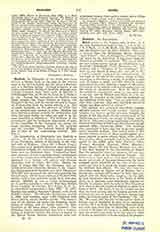

Babel occurs in the Vulgate only in Gen., xi, 9;: the form Babylonia is found in Bar., i, 1, 4; ii, 22; vi, 1-3; I Mach., vi, 4; II Mach., viii, 20; everywhere else the Vulgate uses the form Babylon. The word is derived from the Babylonian bab-ilu, meaning: “gate of God“. Gen., xi, 9 suggests a different meaning based on the derivation of the name from the Hebrew word balal, to confound. The city of Babylon had various names among its inhabitants, e.g. Ka-dingir, Babi-dingir, Tintir, Shu-an-na, etc. The prophets call it “daughter of the Chaldeans” (Is., xlvii, 1), and Sesach or Sesac (Jer., xxv, 26; li, 41), a word variously explained by commentators. It. was built on the site of the modern village of Hille. According to Herodotus, a double or perhaps a triple wall, 50 cubits in width and 200 cubits in height, surrounded the town, forming a square of 120 stadia. The square of the interior wall was 90 stadia long and 360 stadia in circumference. Both the Bible and the cuneiform inscriptions assign a very great age to the city, and the Biblical data (Gen., xi, 1-9) concerning the material of the walls are confirmed by the testimony of the ruins. “Let us make brick, and bake them with fire. And they had brick instead of stones, and slime instead of mortar.”
The ancient city possessed marvellous temples, splendid palaces, and curious gardens. Among the temples, two deserve special attention, E-sagila, the temple of Bel Merodach, on the eastern bank of the Euphrates, and E-zida, the temple of Nebo, west of the river. The ruins of these sanctuaries are probably identical with those of Babil and Birs Nimrud, though opinions differ concerning Babil. The buildings were pyramidal in form and rose in several, usually seven, steplike sections. The storied tower of Birs Nimrud counts seven of these quadrangular platforms painted in seven colors, black, white, yellow, blue, scarlet, silver, and gold, and in the same order sacred to the stellar gods, Adar (Saturn), Ishtar (Venus), Merodach (Jupiter), Nebo (Mercury), Nergal (Mars), Sin (the Moon), Shamash (the Sun). It has been learned in the excavations at Nippur that the pyramidal tower or ziggurrat did not constitute the whole of the Babylonian Temple. This latter had an inner and an outer court, both nearly square and nearly of the same dimensions; the tower occupied about one-third of the area of the inner court, and near to it stood the temple proper where the sacrifices were offered. We may infer from the discoveries made in Nippur and in Sippara that a. library and a school will be found to have been connected with the Babylonian temples. In the light of these discoveries the story of the Tower of Babel (Gen., xi, 4) assumes a new importance, whether we identify its remains with the ruins of Birs Nimrud or with those of the Bel temple at Nippur, or again with those of Babil. No doubt, it was its temples not less than its royal palaces and its hanging gardens that rendered the city of Babylon “glorious among kingdoms, the famous pride of the Chaldeans” (Is., xiii,. 19). We meet with the city at the earliest dawn of history, and it flourishes, in spite of its temporary reverses, till it is finally destroyed by Seleucus Nicator; even then Jews kept on inhabiting some of the mounds of Babylon till about A.D. 1000, after which time the country was given up to the roaming tribes of Arabs, in accordance with the words of the prophet: “wild beasts shall rest there, and their houses shall be filled with serpents, and ostriches shall dwell there, and the hairy ones shall dance there: and owls shall answer one another there, in the houses thereof, and sirens in the temples of pleasure” (Is., xiii, 21-22). (See Tower of Babel. Babylonia.)
A.J. MAAS

